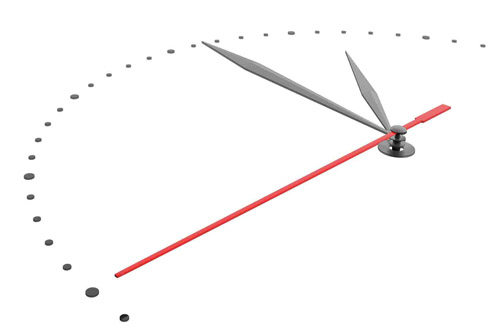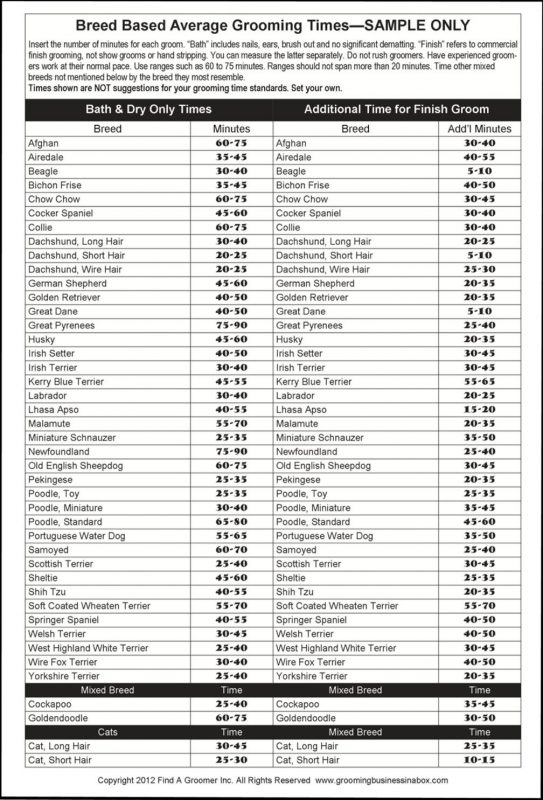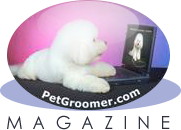
by Grooming Business in a Box®
Our goal as employers should be to pay the best wages in return for the best grooming performance we are fortunate to hire. “Best” would include productivity, quality, humane pet care, teamwork, steady attendance and general adherence to policies and procedures.
There are tens of thousands of grooming businesses. Few have written grooming performance standards for their employees (or independent contractors). Fairness requires grooming employers to set and apply performance standards to avoid the risk of bias and confusion when judging the performances of their employees.
There are several types of standards to set for grooming performances (see From Problems to Profits book). In this article the focus is productivity and its standards based on grooming times.
We expect high grooming quality and humane pet care. Faster, meaning shorter grooming times, is never acceptable where there is a loss of quality or humane pet care. Don’t be fooled by those who feel they must defend their significantly extended grooming times as better quality. Extended grooming time alone is no guarantee of quality grooming or humane pet care. In fact, the longer the groom the more time the pet is separated from its owner.
Setting reasonable grooming times and productivity levels requires a common sense approach. 1) Well-trained, healthy, and experienced groomers should have the highest productivity. 2) New groomers have the lowest. 3) Groomers with temporary or permanent disabilities require adjusted productivity expectations.
Some job candidates want to work on a basis of productivity to which they feel comfortable. If it matches their employer’s expectations, it can work. Use common sense.
Productive employees delivering quality grooming and humane pet care deserve the recognition and compensation that matches their standards. They deserve the best wage levels.
New groomers require more time to groom pets while they safely raise their productivity levels with hands-on experience and supervision. They should expect to earn less during this phase until they reach milestones you set for productivity.
When done properly all employees are classified according to fair performance standards. They earn fair and balanced wages based on their grooming productivity. As a result none of the employees should feel rushed or expected to groom more than the productivity basis for their compensation.
Employer expectations should be documented in personnel job descriptions and agreements (see From Problems to Profits book for samples). Changes will occur. For example, new groomers will reach milestone increases in their productivity and overall performance. Their personnel files should note evidence of the progress and the adjustments made in compensation and sometimes job titles.
Unfortunately almost everything discussed thus far does not exist in most independent grooming businesses. Where it may exist in practice, it may not be in documented form. It must be both or employers are needlessly at risk of employment-related problems.
Standards for Grooming Time
Time plays a major role in wage systems. Grooming is all about hands-on labor. Time is something the effective grooming business manager can easily document daily.
The operations forms and computer software used by employees should document time spent on every grooming. Using actual figures, instead of estimates or guesses, owners of businesses can accurately determine average grooming times for their pet clientele.
Using average grooming time standards employers can more accurately set standards for the job positions they offer. For example, here are some time-based standards set by Madeline Ogle, author of From Problems to Profits, in her business during the years 1961-1986.

Experienced Pet Bather
Average of 12 pets a day in 8 working hours.
Pet bathers prep pets including ears, nails and de-matting when necessary. They bathe pets and hand-dry them, no cage drying. Experienced bathers do Poodle feet clipping where required.
They can finish bath-only pets as needed with “bun and bows,” scissor around feet and between pads as required.
They note physical and sometimes behavioral observations of pets on their respective Madson Pet Groomer’s Report and Health Alert forms, and note on the Madson Client & Pet History Filecards their initials as the provider of the bathing services.
They contact the manager when observations indicate a potential health condition which may require veterinary care.
The manager signs the Madson Pet Groomer’s Report and Health Alert form when conditions warrant a medical advisory recommendation advising pet owners to seek veterinary care.
Bathing Department Supervisor
Average of 10 pets a day in 8 working hours.
The supervisor does fewer bathing services in order to closely supervise the bathing operation. New pet bathers receive instruction and supervision from the supervisor.
Other supervisory duties included restocking bathing supplies, mixing shampoos and conditioners and ensuring the department was thoroughly cleaned and in order for the next working day.
The position provides assurance for business owners that all people and pets in the bathing department are safe at all times, and quality control guaranteed.
Entry-Level Pet Bather
Average of 4 to 6 pets day in 8 working hours.
Entry-level pet bathers do not do Poodle feet, special care pets, scissoring pet feet or intensive de-matting unless they are in training and under active supervision.
Today business owners tell us Madeline’s performance expectations in terms of pets groomed are relatively moderate. Why? Madeline’s business operated before the advent of high velocity dryers and improved bathing products. In the end you as the owner will have to evaluate and set your standards for grooming time.
We suggest you compile a chart of grooming time averages for your operation. You can make your own, or they are included on CD-ROM Groomer Wage System by Grooming Business in a Box.
Once completed for your business, share it with your staff. Make sure they understand its meaning and that its stated times are expections, but based on their level of experience you understand they may not be able to meet the standards. However, explain that you are there to assist them to reach these standards with training and supervision.
Breed Based Grooming Time Averages
Every business should have a list of primary breeds and their expected average grooming times by an experienced pet groomer or pet bather as applicable.
State a range of time not spread by more than 20 minutes. For example, state the time in this format, 45 to 65 minutes.
Ranges account for variables in the sizes of pets. There are small Shelties and large Shelties. Ranges are not only required due to pet sizes. How modern is your equipment? Are you using products that speed up the drying process? Are you using low quality scissors instead of high grade scissors? We know excellent groomers including ourselves that found scissoring time was cut by up to one-third when they used better quality precision shears.
Do you use high velocity dryers? Few argue they have proven to be significant timesavers compared to the times when early stand dryers were the only option.
These are just a few reasons why grooming times must be stated in ranges. Don’t use another business owner’s chart of grooming times without updating the times specific to the state of your operation.
We suggest putting a copy of your completed chart in your employee handbook. Have job candidates review copies too. Ask their opinion where there current performance standards stands with your range of time expectations.
Refer to the chart when you state expectations for the number of pets to be bathed or groomed on personnel documentation.
If you state 15 bath and dry services in 8 hours (480 minutes) your expectation is an average of 32 minutes per bathing services.
Refer to your chart. How possible is that goal on a regular basis when many of your bath and dry times are well over 32 minutes? Be reasonable.
There is another important variable to consider. The times in your chart should measure dedicated time grooming one-on-one. Although it is possible for pet bathers in well-equipped bathing departments to have enough space to actively work on more than one pet at a time, do not take that into consideration in setting times for your chart.
You can learn more about time standards and access many more fill-in wage-related forms like the chart in this article in CD #4, Pet Groomer Wage Systems by Grooming Business in a Box®.


